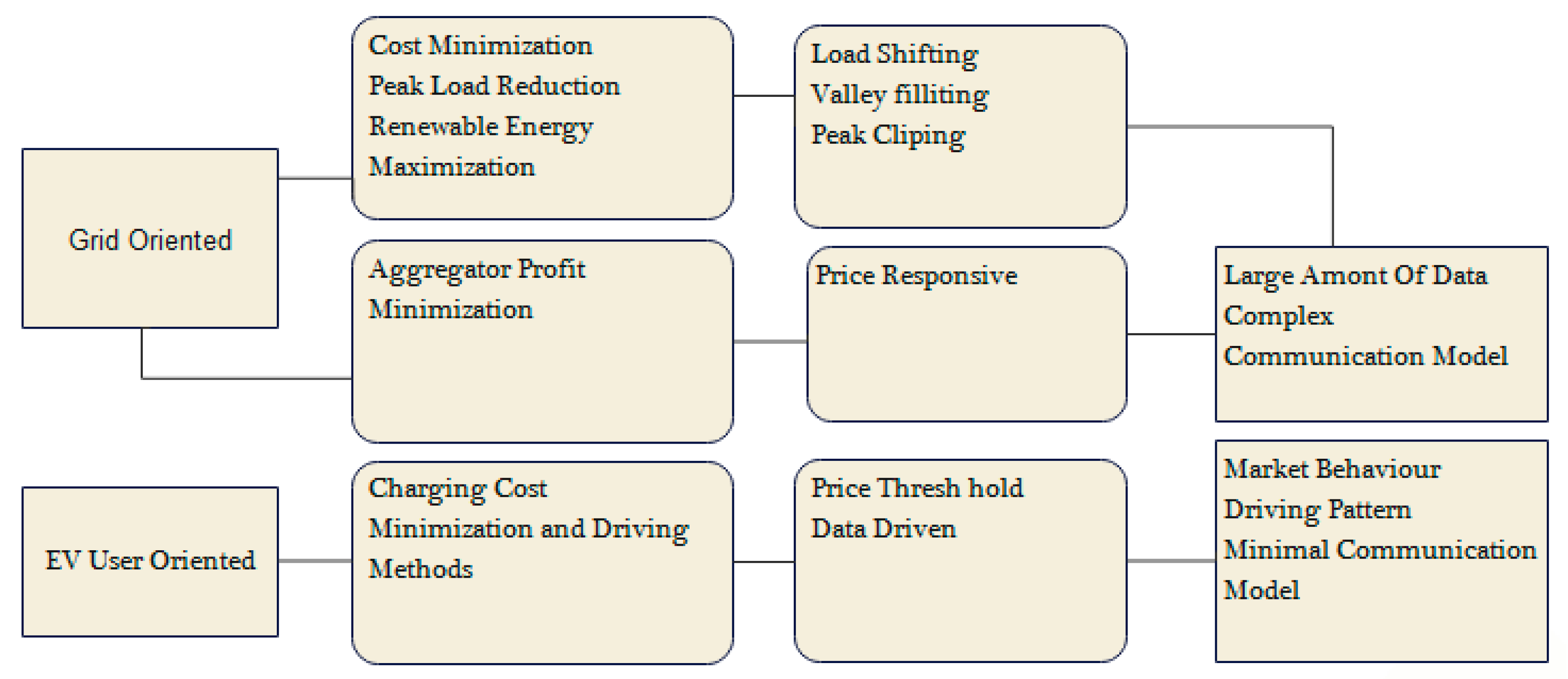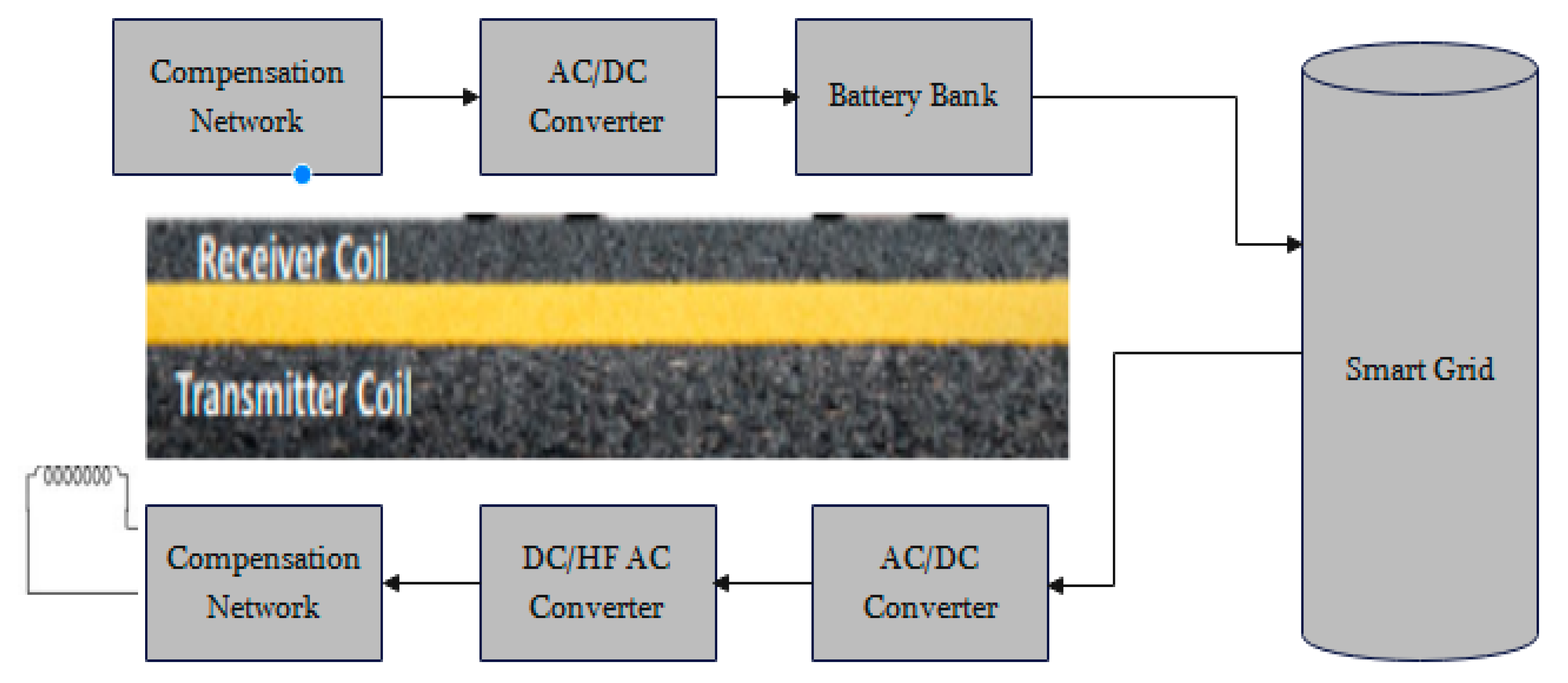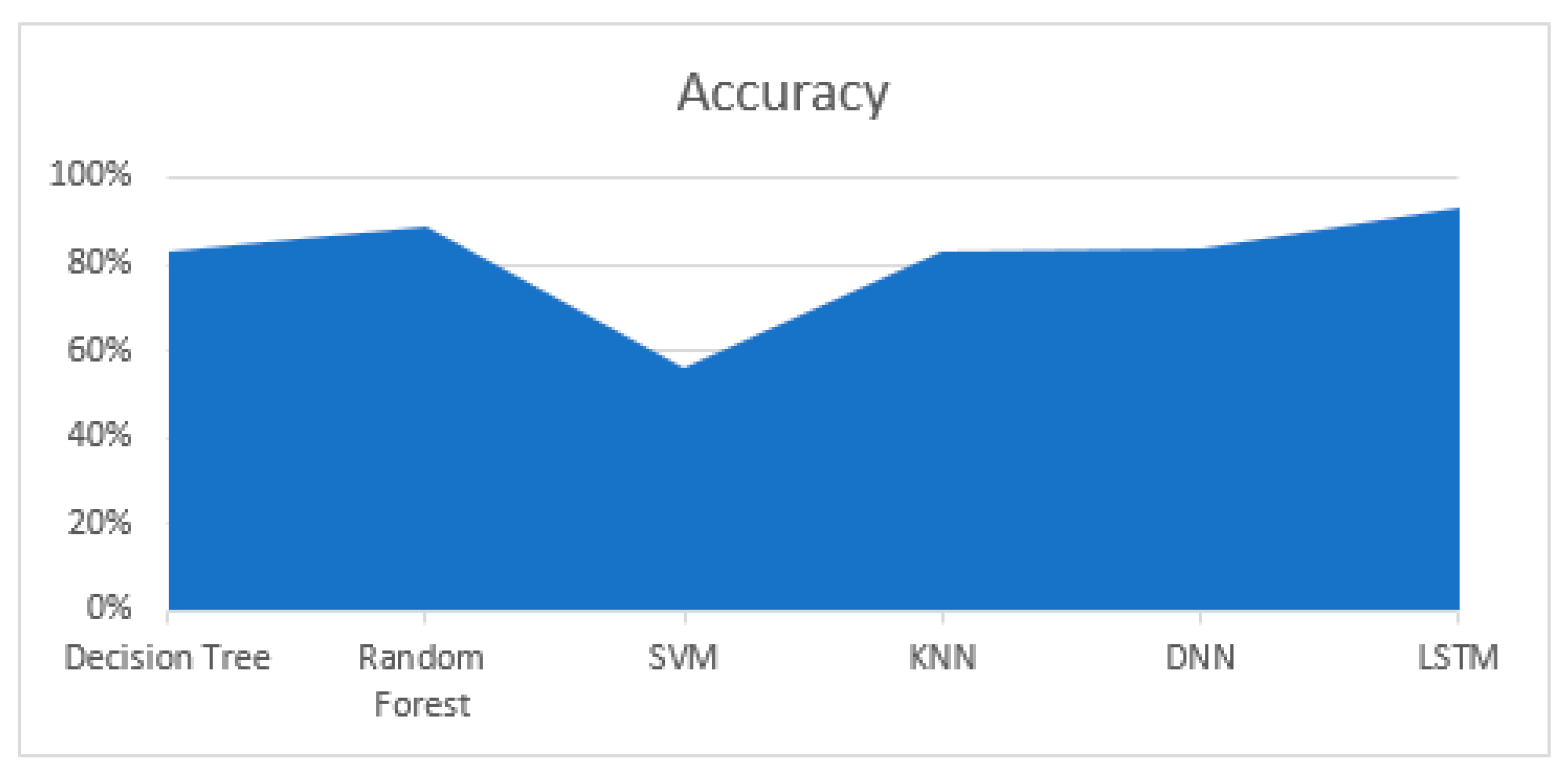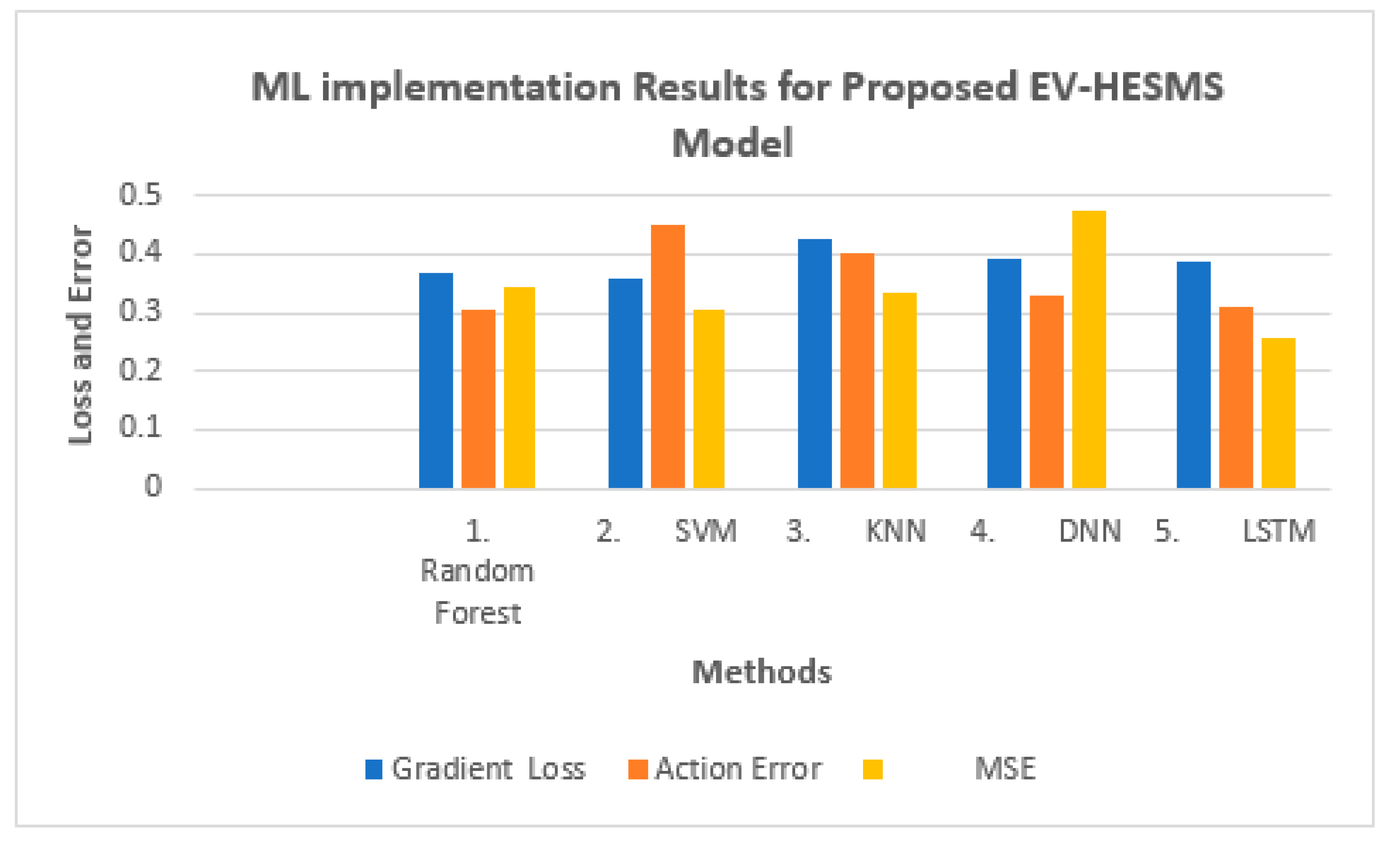Electric Vehicle Charging System in the Smart Grid Using Different Machine Learning Methods
Abstract
:1. Introduction
1.1. Intelligent Information Management in Smart Cities Promotes Energy and Governance Sustainability
1.2. The Vehicle to Grid (V2G) Network Is a Crucial Development for the Smart Grid
1.3. Integration of EVs in Smart Grids
2. Literature Review
2.1. Managed Charging of Electric Vehicle
2.2. Types of Contactless EVS
2.3. Machine Learning Techniques
3. Methodology
3.1. Machine Learning
3.2. Learning Algorithms
3.3. Proposed Methods
4. Data Acquisition
5. Results
5.1. Machine Learning Models:
5.1.1. Charging Station Classification Results
5.1.2. Classification Based on Charging
5.2. The Impact of Uncertain Load Data on the EV Management System
Variation in Load Data and Its Impact on Machine Learning Accuracy
5.3. Mathematically Model to Different Calculated Parameters:
5.4. Limitations of the Proposed System
- (1)
- More advanced deep learning, reinforcement learning, and federated learning techniques can be used to centralize this system, enabling more effective vehicle utilization regulation. Obviously, if there are more providers vying for fewer stations, the problem will improve.
- (2)
- The dataset should contain more parameters. Electric vehicle (EV) sales have been increasing, and this trend is likely to continue as prices fall and ranges increase. Currently, the percentage of electric cars (EVs) in use is quite modest. Any company that has a parking lot for clients or staff will be impacted by this. Therefore, it is crucial for businesses to consider how their energy policy will change as a result of planned changes to EVs and EV charging. Particularly for businesses, having multiple chargers or fast-charging equipment on hand is essential.
- (3)
- As automakers work to reduce the amount of time needed to charge an EV so that the “refueling” process is more equivalent to that of a normal vehicle, chargers need more power.
6. Conclusions
Author Contributions
Funding
Institutional Review Board Statement
Informed Consent Statement
Data Availability Statement
Conflicts of Interest
References
- IEA, C. Global EV Outlook 2020. 2020. Available online: https://www.iea.org/reports/global-ev-outlook-2020 (accessed on 1 February 2022).
- Dhakal, T.; Kangwon National University; Min, K.-S. Macro Study of Global Electric Vehicle Expansion. Foresight STI Gov. 2021, 15, 67–73. [Google Scholar] [CrossRef]
- Elmenshawy, M.; Massoud, A. Modular Isolated DC-DC Converters for Ultra-Fast EV Chargers: A Generalized Modeling and Control Approach. Energies 2020, 13, 2540. [Google Scholar] [CrossRef]
- Shibl, M.; Ismail, L.; Massoud, A. Electric Vehicles Charging Management Using Machine Learning Considering Fast Charging and Vehicle-to-Grid Operation. Energies 2021, 14, 6199. [Google Scholar] [CrossRef]
- Lytras, M.D.; Visvizi, A.; Jussila, J. Social media mining for smart cities and smart villages research. Soft Comput. 2020, 24, 10983–10987. [Google Scholar] [CrossRef]
- Morvaj, B.; Lugaric, L.; Krajcar, S. Demonstrating smart buildings and smart grid features in a smart energy city. In Proceedings of the 2011 3rd International Youth Conference on Energetics (IYCE), Leiria, Portugal, 7–9 July 2011. [Google Scholar]
- Qaisar, S.M.; Alyamani, N. A Review of Charging Schemes and Machine Learning Techniques for Intelligent Management of Electric Vehicles in Smart Grid. Manag. Smart Cities 2022, 51–71. [Google Scholar] [CrossRef]
- Axelsson, K.; Granath, M. Stakeholders’ stake and relation to smartness in smart city development: Insights from a Swedish city planning project. Gov. Inf. Q. 2018, 35, 693–702. [Google Scholar] [CrossRef]
- Lytras, M.D.; Chui, K.T. The Recent Development of Artificial Intelligence for Smart and Sustainable Energy Systems and Applications. Energies 2019, 12, 3108. [Google Scholar] [CrossRef]
- Liu, Z.; Wu, Q.; Huang, S.; Wang, L.; Shahidehpour, M.; Xue, Y. Optimal Day-Ahead Charging Scheduling of Electric Vehicles Through an Aggregative Game Model. IEEE Trans. Smart Grid 2017, 9, 5173–5184. [Google Scholar] [CrossRef]
- Wang, T.; Liang, Y.; Jia, W.; Arif, M.; Liu, A.; Xie, M. Coupling resource management based on fog computing in smart city systems. J. Netw. Comput. Appl. 2019, 135, 11–19. [Google Scholar] [CrossRef]
- Dericioğlu, C.; Yirik, E.; Ünal, E.; Cuma, M.U.; Onur, B.; Tümay, M. A Review of Charging Technologies for Commercial Electric Vehicles. Int. J. Adv. Automot. Technol. 2018, 2, 61–70. [Google Scholar] [CrossRef]
- Wang, S.; Wan, J.; Li, D.; Zhang, C. Implementing smart factory of industrie 4. 0: An outlook. Int. J. Distrib. Sens. Netw. 2016, 12, 3159805. [Google Scholar]
- Danish, M.S.S.; Bhattacharya, A.; Stepanova, D.; Mikhaylov, A.; Grilli, M.L.; Khosravy, M.; Senjyu, T. A Systematic Review of Metal Oxide Applications for Energy and Environmental Sustainability. Metals 2020, 10, 1604. [Google Scholar] [CrossRef]
- Ehsani, M.; Gao, Y.; Gay, S.E.; Emadi, A. Modern Electric, Hybrid Electric, and Fuel Cell Vehicles; CRC Press: Boca Raton, FL, USA, 2018. [Google Scholar]
- Cattaruzza, D.; Absi, N.; Feillet, D.; González-Feliu, J. Vehicle routing problems for city logistics. EURO J. Transp. Logist. 2017, 6, 51–79. [Google Scholar] [CrossRef]
- Xydas, E.S.; Marmaras, C.E.; Cipcigan, L.M.; Hassan, A.S.; Jenkins, N. Forecasting electric vehicle charging demand using support vector machines. In Proceedings of the 2013 48th International Universities’ Power Engineering Conference (UPEC), Dublin, Ireland, 2–5 September 2013. [Google Scholar]
- Sadeghian, O.; Oshnoei, A.; Mohammadi-Ivatloo, B.; Vahidinasab, V.; Anvari-Moghaddam, A. A comprehensive review on electric vehicles smart charging: Solutions, strategies, technologies, and challenges. J. Energy Storage 2022, 54, 105241. [Google Scholar] [CrossRef]
- Vu, Q.V.; Dinh, A.H.; Van Thien, N.; Tran, H.T.; Le Xuan, H.; Van Hung, P.; Kim, D.T.; Nguyen, L. An Adaptive Hierarchical Sliding Mode Controller for Autonomous Underwater Vehicles. Electronics 2021, 10, 2316. [Google Scholar] [CrossRef]
- Huang, X.; Shi, J.; Gao, B.; Tai, Y.; Chen, Z.; Zhang, J. Forecasting Hourly Solar Irradiance Using Hybrid Wavelet Transformation and Elman Model in Smart Grid. IEEE Access 2019, 7, 139909–139923. [Google Scholar] [CrossRef]
- Quesada, J.A.; Lopez-Pineda, A.; Gil-Guillén, V.F.; Durazo-Arvizu, R.; Orozco-Beltrán, D.; López-Domenech, A.; Carratalá-Munuera, C. Machine learning to predict cardiovascular risk. Int. J. Clin. Pr. 2019, 73, e13389. [Google Scholar] [CrossRef]
- Zhai, Z.; Su, S.; Liu, R.; Yang, C.; Liu, C. Agent–cellular automata model for the dynamic fluctuation of EV traffic and charging demands based on machine learning algorithm. Neural Comput. Appl. 2018, 31, 4639–4652. [Google Scholar] [CrossRef]
- Rigas, E.S.; Ramchurn, S.D.; Bassiliades, N. Managing Electric Vehicles in the Smart Grid Using Artificial Intelligence: A Survey. IEEE Trans. Intell. Transp. Syst. 2014, 16, 1619–1635. [Google Scholar] [CrossRef]
- Sangdehi, S.M.M.; Hamidifar, S.; Kar, N.C. A Novel Bidirectional DC/AC Stacked Matrix Converter Design for Electrified Vehicle Applications. IEEE Trans. Veh. Technol. 2014, 63, 3038–3050. [Google Scholar] [CrossRef]
- Sultana, B.; Mustafa, M. Impact of reconfiguration and demand response program considering electrical vehicles in smart distribution network. In Proceedings of the 3rd International Electrical Engineering Conference (IEEC 2018), Karachi, Pakistan, 9–10 February 2018. [Google Scholar]
- Ramirez-Vazquez, R.; Gonzalez-Rubio, J.; Escobar, I.; Suarez Rodriguez, C.D.P.; Arribas, E. Personal exposure assessment to Wi-Fi radiofrequency electromagnetic fields in Mexican microenvironments. Int. J. Environ. Res. Public Health 2021, 18, 1857. [Google Scholar] [CrossRef] [PubMed]
- Lund, P.D.; Byrne, J.; Haas, R.; Flynn, D. (Eds.) The role of electric vehicles in smart grids. In Advances in Energy Systems: The Large-scale Renewable Energy Integration Challenge; John Wiley & Sons: Hoboken, NJ, USA, 2019; pp. 245–264. [Google Scholar]
- Amer, A.; Shaban, K.; Gaouda, A.; Massoud, A. Home Energy Management System Embedded with a Multi-Objective Demand Response Optimization Model to Benefit Customers and Operators. Energies 2021, 14, 257. [Google Scholar] [CrossRef]
- Ashraf, S. Culminate Coverage for Sensor Network Through Bodacious-instance Mechanism. In I-Manager’s Journal on Wireless Communication Networks; I-Manager Publications: Nagercoil, India, 2019; Volume 8, p. 1. [Google Scholar] [CrossRef]
- Jian, L.; Xue, H.; Xu, G.; Zhu, X.; Zhao, D.; Shao, Z.Y. Regulated Charging of Plug-in Hybrid Electric Vehicles for Minimizing Load Variance in Household Smart Microgrid. IEEE Trans. Ind. Electron. 2012, 60, 3218–3226. [Google Scholar] [CrossRef]
- Moghaddam, Z.; Ahmad, I.; Habibi, D.; Phung, Q.V. Smart Charging Strategy for Electric Vehicle Charging Stations. IEEE Trans. Transp. Electrification 2017, 4, 76–88. [Google Scholar] [CrossRef]
- Hu, J.; Morais, H.; Sousa, T.; Lind, M. Electric vehicle fleet management in smart grids: A review of services, optimization and control aspects. Renew. Sustain. Energy Rev. 2016, 56, 1207–1226. [Google Scholar] [CrossRef]
- Karmaker, A.K.; Roy, S.; Ahmed, R. Analysis of the impact of electric vehicle charging station on power quality issues. In Proceedings of the 2019 International Conference on Electrical, Computer and Communication Engineering (ECCE), Chittagong, Bangladesh, 7–9 February 2019. [Google Scholar]
- Ashraf, S.; Alfandi, O.; Ahmad, A.; Khattak, A.M.; Hayat, B.; Kim, K.H.; Ullah, A. Bodacious-Instance Coverage Mechanism for Wireless Sensor Network. Wirel. Commun. Mob. Comput. 2020, 2020, 8833767. [Google Scholar] [CrossRef]
- Dileep, G. A survey on smart grid technologies and applications. Renew. Energy 2019, 146, 2589–2625. [Google Scholar] [CrossRef]
- Yilmaz, M.; Krein, P.T. Review of the Impact of Vehicle-to-Grid Technologies on Distribution Systems and Utility Interfaces. IEEE Trans. Power Electron. 2012, 28, 5673–5689. [Google Scholar] [CrossRef]
- Carli, R.; Dotoli, M. A Distributed Control Algorithm for Optimal Charging of Electric Vehicle Fleets with Congestion Management. IFAC-PapersOnLine 2018, 51, 373–378. [Google Scholar] [CrossRef]
- Yong, J.Y.; Ramachandaramurthy, V.K.; Tan, K.M.; Mithulananthan, N. A review on the state-of-the-art technologies of electric vehicle, its impacts and prospects. Renew. Sustain. Energy Rev. 2015, 49, 365–385. [Google Scholar] [CrossRef]
- Clairand, J.-M.; Guerra-Terán, P.; Serrano-Guerrero, X.; González-Rodríguez, M.; Escrivá-Escrivá, G. Electric Vehicles for Public Transportation in Power Systems: A Review of Methodologies. Energies 2019, 12, 3114. [Google Scholar] [CrossRef]
- Panchal, C.; Stegen, S.; Lu, J. Review of static and dynamic wireless electric vehicle charging system. Eng. Sci. Technol. Int. J. 2018, 21, 922–937. [Google Scholar] [CrossRef]
- Stüdli, S.; Crisostomi, E.; Middleton, R.; Shorten, R. A flexible distributed framework for realising electric and plug-in hybrid vehicle charging policies. Int. J. Control. 2012, 85, 1130–1145. [Google Scholar] [CrossRef]
- Ashraf, S.; Ahmed, T.; Saleem, S. NRSM: Node redeployment shrewd mechanism for wireless sensor network. Iran J. Comput. Sci. 2020, 4, 171–183. [Google Scholar] [CrossRef]
- Hoke, A.; Brissette, A.; Smith, K.; Pratt, A.; Maksimovic, D. Accounting for Lithium-Ion Battery Degradation in Electric Vehicle Charging Optimization. IEEE J. Emerg. Sel. Top. Power Electron. 2014, 2, 691–700. [Google Scholar] [CrossRef]
- Scarabaggio, P.; Carli, R.; Cavone, G.; Dotoli, M. Smart control strategies for primary frequency regulation through electric vehicles: A battery degradation perspective. Energies 2020, 13, 4586. [Google Scholar] [CrossRef]
- Carli, R.; Dotoli, M. A Distributed Control Algorithm for Waterfilling of Networked Control Systems via Consensus. IEEE Control Syst. Lett. 2017, 1, 334–339. [Google Scholar] [CrossRef]
- Murthy, V.N.; Singh, V.; Chen, T.; Manmatha, R.; Comaniciu, D. Deep decision network for multi-class image classification. In Proceedings of the IEEE Conference on Computer Vision and Pattern Recognition, Las Vegas, NV, USA, 27–29 June 2016. [Google Scholar]
- Ma, X.; Tao, Z.; Wang, Y.; Yu, H.; Wang, Y. Long short-term memory neural network for traffic speed prediction using remote microwave sensor data. Transp. Res. Part C Emerg. Technol. 2015, 54, 187–197. [Google Scholar] [CrossRef]
- Deligiannis, P.; Koutroubinas, S.; Koronias, G. Predicting Energy Consumption Through Machine Learning Using a Smart-Metering Architecture. IEEE Potentials 2019, 38, 29–34. [Google Scholar] [CrossRef]
- Manishimwe, A.; Alexander, H.; Kaluuma, H.; Dida, M.A. Integrated Mobile Application Based on Machine Learning for East Africa Stock Market. J. Inf. Syst. Eng. Manag. 2021, 6, em0143. [Google Scholar] [CrossRef]
- Fernandes, A.; Salazar, L.H.; Dazzi, R.; Garcia, N.; Leithardt, V.R.Q. Using Different Models of Machine Learning to Predict Attendance at Medical Appointments. J. Inf. Syst. Eng. Manag. 2020, 5, em0122. [Google Scholar] [CrossRef] [PubMed]
- Rumelhart, D.E.; Smolensky, P.; McClelland, J.L.; Hinton, G.E. is achieved. Prior to stabilization, neural networks do not jump around between points in activation space. Stabiliza-tion is the process whereby a network first generates a de-terminate activation pattern, and thereby arrives at a point in activation space. Behav. Brain Sci. 2004, 27, 2. [Google Scholar]
- Sarker, I.H. Machine Learning: Algorithms, Real-World Applications and Research Directions. SN Comput. Sci. 2021, 2, 1–21. [Google Scholar] [CrossRef] [PubMed]
- Hsu, R.C.; Lin, T.-H.; Su, P.-C. Dynamic Energy Management for Perpetual Operation of Energy Harvesting Wireless Sensor Node Using Fuzzy Q-Learning. Energies 2022, 15, 3117. [Google Scholar] [CrossRef]
- Gui, T.; Liu, P.; Zhang, Q.; Zhu, L.; Peng, M.; Zhou, Y.; Huang, X. Mention recommendation in Twitter with cooperative multi-agent reinforcement learning. In Proceedings of the 42nd International ACM SIGIR Conference on Research and Development in Information Retrieval, Paris, France, 21–25 July 2019. [Google Scholar]
- Liu, T.; Zou, Y.; Liu, D.; Sun, F. Reinforcement Learning of Adaptive Energy Management with Transition Probability for a Hybrid Electric Tracked Vehicle. IEEE Trans. Ind. Electron. 2015, 62, 7837–7846. [Google Scholar] [CrossRef]
- Alsharif, A.; Wei, T.C.; Ayop, R.; Lau, K.Y.; Bukar, A.L. A Review of the Smart Grid Communication Technologies in Contactless Charging with Vehicle to Grid Integration Technology. J. Integr. Adv. Eng. 2021, 1, 11–20. [Google Scholar] [CrossRef]












| Algorithm | Advantages | Disadvantages |
|---|---|---|
| Decision Tree (DT) | Data does not need to be sized or normalized. Regression and classification analyses benefit from it—highly accurate predictions and understanding. | Training takes a while since even little changes to the dataset could greatly impact the final structure. |
| Random Forest (RF) | Capable of processing large datasets with various factors and handling uncertainty while putting out the mean or mode of several decision trees. | The problem is made harder by how many trees are created. Training typically requires a sizable amount of time. |
| Support Vector Machine (SVM) | Classification and regression are possible uses; the classifier’s performance is minimized. | The training procedure takes longer with large datasets—poor performance when there are more features than training samples. |
| K-Nearest Neighbors (KNN) | Both classification and regression analysis can benefit from its use. Shorter training sessions. Clear use of ideas. | We are having poor performance when dealing with huge datasets. Poor performance when dealing with a large number of inputs. Poor performance when dealing with datasets that are not balanced |
| Deep Neural Network (DNN) | A model that may be utilized for various tasks, like classification and regression. | Need enormous data sets very prone to over fitting. The ideal width and depth cannot be determined using a general principle. |
| Long Short-Term Memory (LSTM) | Time series detection, accurate forecasting and adaptability to various applications (classification and regression). | There is no established methodology for determining the optimum breadth and depth. There is no theory for selecting optimal hyper parameters. |
|
|
|
|
|
|
|
|
|
|
|
|
|
|
|
|
|
|
|
|
|
|
|
|
| Machine Learning Model | Accuracy |
|---|---|
| Decision Tree | 93% |
| Random Forest | 94% |
| SVM | 29% |
| KNN | 41% |
| DNN | 77% |
| LSTM | 94% |
| Machine Learning Model | Accuracy |
|---|---|
| Decision Tree | 83% |
| Random Forest | 89% |
| SVM | 56% |
| KNN | 83% |
| DNN | 84% |
| LSTM | 93% |
| Machine Learning Model | Accuracy | Accuracy Change |
|---|---|---|
| DT | 76% | −17% |
| RF | 85% | −9% |
| LSTM | 94% | 0 |
| Machine Learning Model | Accuracy | Accuracy Change |
|---|---|---|
| DT | 83% | 0% |
| RF | 88% | −1% |
| KNN | 84% | 0 |
| DNN | 82% | −2% |
| LSTM | 93% | 0% |
| Methods | Train (80%) | Test (20%) | Gradient Loss | Action Error | MSE |
|---|---|---|---|---|---|
| 1. Random Forest | 2716 | 679 | 0.366 | 0.304 | 0.342 |
| 2. SVM | 2716 | 679 | 0.359 | 0.449 | 0.303 |
| 3. KNN | 2716 | 679 | 0.426 | 0.402 | 0.333 |
| 4. DNN | 2716 | 679 | 0.390 | 0.329 | 0.475 |
| 5. LSTM | 2716 | 679 | 0.386 | 0.310 | 0.258 |
Disclaimer/Publisher’s Note: The statements, opinions and data contained in all publications are solely those of the individual author(s) and contributor(s) and not of MDPI and/or the editor(s). MDPI and/or the editor(s) disclaim responsibility for any injury to people or property resulting from any ideas, methods, instructions or products referred to in the content. |
© 2023 by the authors. Licensee MDPI, Basel, Switzerland. This article is an open access article distributed under the terms and conditions of the Creative Commons Attribution (CC BY) license (https://creativecommons.org/licenses/by/4.0/).
Share and Cite
Mazhar, T.; Asif, R.N.; Malik, M.A.; Nadeem, M.A.; Haq, I.; Iqbal, M.; Kamran, M.; Ashraf, S. Electric Vehicle Charging System in the Smart Grid Using Different Machine Learning Methods. Sustainability 2023, 15, 2603. https://doi.org/10.3390/su15032603
Mazhar T, Asif RN, Malik MA, Nadeem MA, Haq I, Iqbal M, Kamran M, Ashraf S. Electric Vehicle Charging System in the Smart Grid Using Different Machine Learning Methods. Sustainability. 2023; 15(3):2603. https://doi.org/10.3390/su15032603
Chicago/Turabian StyleMazhar, Tehseen, Rizwana Naz Asif, Muhammad Amir Malik, Muhammad Asgher Nadeem, Inayatul Haq, Muhammad Iqbal, Muhammad Kamran, and Shahzad Ashraf. 2023. "Electric Vehicle Charging System in the Smart Grid Using Different Machine Learning Methods" Sustainability 15, no. 3: 2603. https://doi.org/10.3390/su15032603







